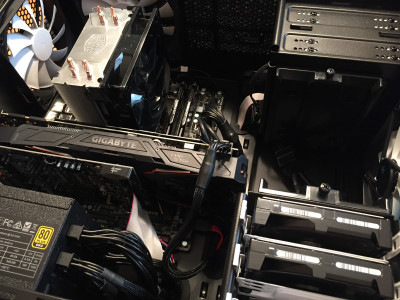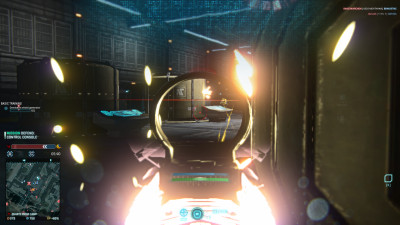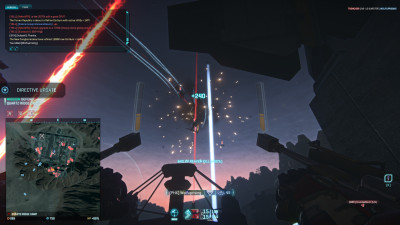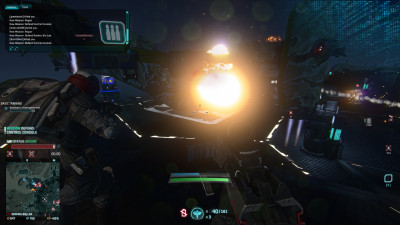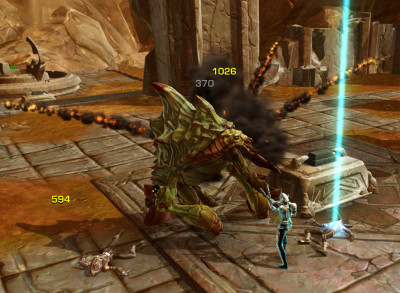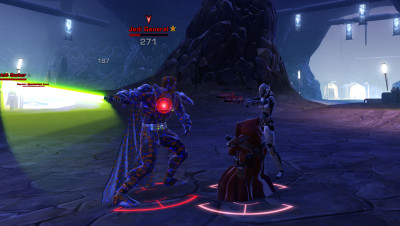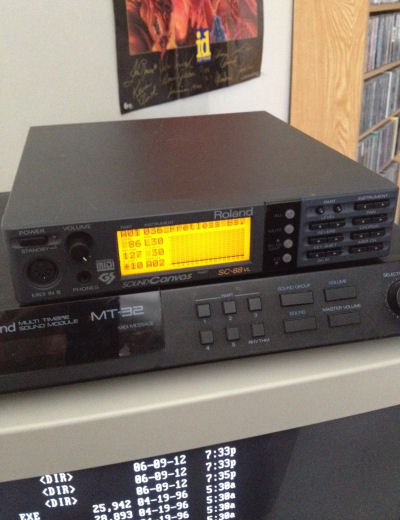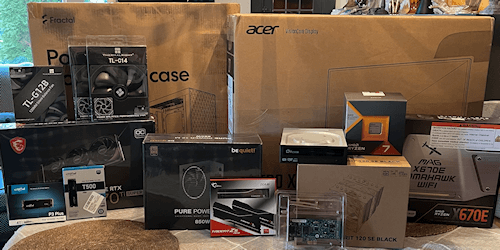
“Big, expensive pile o’ hardware.”
As mentioned in my last post, here’s a little insight into the decisions that went into my new build. This could hopefully help some new builders make decisions regarding their own component selections in the future, though many of the parts selected for this build will be ancient history in only a matter of months. So it goes!
Initial Goals:
Since I’ve had the luxury of enough money to be selective, I’ve used a simple methodology for my own personal PC builds, and I’ve always been pleased with the results. I start by looking at popular, commonly recommended specs and specific components, and then do a huge amount of research on those components, tweaking them to avoid technical issues as well as conform to my own brand and feature preferences. Most importantly, I will adjust those components until I hit the sweet spot between performance and price – usually there is a very obvious cutoff where spending more goes above what I’m comfortable with and/or no longer feels like a reasonable upgrade for the cost. The end result is typically a premium spin on a mid range gaming machine that has just enough added oomph to serve me well for productivity purposes, and last a very, very long time with (hopefully) minimal issues. My current (now old) machine has lasted me 8 years and is still going relatively strong, with only a couple of minor upgrades along the way, and I had my last machine for a similar amount of time.
The thing is, having my PCs stick around so long was never really a stated goal. It’s a combination of being somewhat frugal with my money (read: cheap) and also absolutely hating migrating from one primary machine to another. I usually make a ton of tweaks to my systems, I run servers, do development, and do a bit of casual data hoarding. It’s by far the most unpleasant part of building a new machine for me. This time around, I’ve decided that I can no longer deny that truth – I’m going to purposely build a machine that can last me a ridiculously long time. Of course, it’s hard to predict everything that could happen in the next ~8 years, but I can at least do a couple of things that can help.
First, I’ll invest more in the basics like CPU and RAM upfront. Since heavy multitasking, including running some VMs, will be my primary use-case outside of gaming, I’ll want to go with a processor which both has a ton of cores as well as great gaming performance. I’ll also start with an unreasonably large amount of RAM. Second, I’ll spec some of these parts in a way that will more easily allow for an upgrade at around the midpoint of this PC’s lifespan – For example, I’d like to be able to relatively easily swap in a new CPU and/or GPU without needing to replace my motherboard, if possible. This means perhaps spending a tiny bit more now for features I might only be using down the line.
The timing of this build is interesting and needs a mention too. I’d originally had loose plans to build a new machine sometime later in 2025, but as an American, the threat of large tariffs on imports from many countries, not the least being China, possibly driving up component prices became much more realistic after the election in November 2024. My decision to bump up my build to late 2024 also happened to coincide with the innumerable end of November sales associated with the the holidays, particularly the weeks of Black Friday and Cyber Monday. As such, despite the very recent launch of AMD’s new Ryzen 9000 series and looming announcements from NVIDIA about the RTX GeForce 5000 series, I decided to dive in right then and there.
CPU Selection:
This is usually the most logical place to start with any build, as it will dictate my motherboard selection, what memory I need, etc. and the rest will kind of fall into place from there.
I was immediately confronted with a lot of unexpected complications right out of the gate. While I won’t go into detail here, the high-end Intel CPUs like the 13900K and 14900K I was looking at, really all 13th and 14th generation Intel CPUs, have had some controversial issues around stability. I also have some (relatively minor) concerns over their whole “performance core” vs “efficiency core” scheduling thing.
This led me to looking at AMD’s Ryzen processors, which have been making big waves for a while now. I was immediately impressed to learn how much less power they draw and heat they generate, which practically sold me all by itself. The Ryzen 9 7950X3D seemed like the obvious choice for both gaming and productivity, but I quickly discovered all of the numerous multitasking issues associated with its 16 cores being divided between 2 different chiplet dies, and only one including the 3D cache. I almost went with this regardless, as the common workaround of using Process Lasso or similar tools to manually assign programs to the two different CCDs didn’t seem too challenging, but the deeper I looked, the more I discovered reports of incompatibility with certain programs (specifically games) and some other big issues that only added to the potential headaches involved in using this processor. I run a lot of older applications and games, so such incompatibilities are a bit scarier to me than they might be for your average gamer who is only playing the latest releases.
Speaking of gamers, a lot of people recommended the Ryzen 7 7800X3D, which apparently still beats the 7950X3D and virtually all other newer processors when it comes to pure gaming. With only 8 symmetrical cores/16 threads living on a single die, the 7800X3D doesn’t have any of the core scheduling issues the 7950X3D has. Of course, it also has half the cores. That said, I find the commonly repeated recommendation that you need a 7950X3D for productivity while the 7800X3D is only for gaming to be a little reductive. My relatively ancient 4 core I7 can handle productivity tasks, including running a dedicated VM, quite well. With double the cores, and many games using 6 cores or less, this should be a huge improvement for me. I’m also not gaming for hours every day these days (sadly) and the type of productivity work I do doesn’t require crunching a huge amount of data (rendering, etc.) that would greatly benefit by throwing more cores into the mix. With that, I settled on the Ryzen 7 7800X3D.
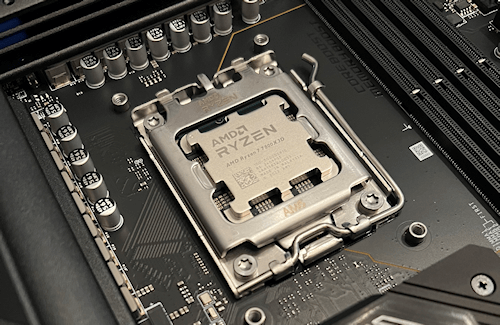
“Freshly installed!”
I should mention that when I started working on this the Ryzen 9 9800X3D had only just been released. Coming in at very close to the same price as the 7800X3D with all of the other advantages of it along with being ~10% faster, this might have been a more logical choice if it weren’t so new, and availability and subsequent artificial price increases weren’t a thing. I’m not worried about this, but I am really intrigued to see what the next generation or two of 7950X3D equivalent processors look like – maybe some of their issues will be sorted out, whether by AMD or Microsoft. In any case, I’m thinking I’ll end up throwing something from the last line of AM5 processors into this thing when/if I do my mid-life upgrade, assuming my motherboard can support it.
While I’m on the subject, I’ll use a Thermalright Phantom Spirit 120 SE on this for cooling. I used a Silent Assassin on another recent build and these coolers are quite well regarded, especially for their price. The 7800X3D doesn’t need anything too crazy, but this is a nice enough cooler to work with something beefier way down the line, and I’d rather go a bit heavy handed with cooling than have thermal issues later, and this thing is still quite cheap regardless.
Motherboard Selection:
This is the decision I struggled with the most. At first, I was pointed to B650 chipset motherboards, of which there are a huge number and some with very nice feature sets, though uncomfortably high prices and a general lack of availability often accompany the higher end boards. Initially I settled on the MSI MAG Tomahawk B650 WIFI due to having great VRM timings which would hopefully help support a future processor upgrade and/or future overclocking endeavors, along with the rest of its feature set. There are better choices, but again, my selection was heavily tempered by price and availability, and I’ve had good luck with MSI products in the past.
The biggest thing the Tomahawk B650 lacked was PCIe Gen 5 support. Now, I don’t currently need PCIe Gen 5 support, but I kept coming back to the idea of “future proofing” this build for a mid-life upgrade. While a Gen 5 GPU likely won’t be required even then, having it available will at least give me more options. The same is true with PCIe 5.0 M.2 drives – current testing suggests that they run incredibly hot, and unless you’re very comfortable with an optimized cooling setup, should probably be avoided for now if you don’t have a legitimate need for such blazing speeds, so I’m not going to worry about them. In the future, Gen 5 NVMEs might improve in that area, so this is another “nice to have.”
Naturally, I started looking at the MSI Tomahawk X670E WIFI instead. This motherboard includes a single Gen 5 PCIe x16 slot and a single Gen 5 M.2 slot, while overall being a fairly similar board. Another notable feature is the inclusion of an ALC1200 chip instead of ALC4080 for sound. This is a minor concern, and which one of these codec chips is better is fairly contested, but the tried and trusted ALC1200 feels like less of a potential problem, and sound is important to me. In fact, this will be the first time I’ve put together a personal build that doesn’t include a dedicated sound card (although, if I do end up having any sound issues, that will be an early upgrade!)
Anyway, one basic requirement this motherboard doesn’t meet is that I was hoping to have two onboard NICs. One improvement I’m going to make to my server setup with this machine is to have my primary VM use a dedicated NIC on its own a segregated VLAN. I could accomplish this with only one NIC using VLAN tagging, sure, but quite a lot of desktop NIC drivers don’t support 802.1x and I’ve even had one that did lose all of its associated configuration options after a driver update. Yikes. Two NICs is ultimately more reliable. Unfortunately, I couldn’t find any AM5 motherboards that included this option and were reasonably priced, so I’m going to throw a Intel EXPI9301CTBLK Gigabit Network Card into one of my slower PCIe slots.
Back to the subject of the motherboard, unfortunately, the more I researched MSI’s line of AM5 motherboards, the more issues I ran across. Honestly, you’ll find issues that are at least a little concerning with ANY motherboard if you dig enough, but there were a couple of widespread issues that required me to make some major changes to my early part choices. This almost scared me off of MSI entirely, but ultimately I feel like my concessions were fine.
Memory Selection:
Continuing from the above, first of all, people complaining about memory issues and associated stability problems, often related to using XMP and especially EXPO, with DDR5, is common. During troubleshooting, whether or not the memory is officially supported is one related concern. I’d initially selected the cheapest set of G.Skill EXPO RAM I could find, the Flare X5. While lower capacity kits are in the compatibility list, the exact one I picked was not. After looking at my options for quite a while, I eventually settled on the slightly more expensive G.Skill Trident Z5 Neo which is on the list, is well regarded, and reviews suggest it works well with EXPO.
As for how much, I opted for 16 GB on my current build, but decided to throw another 16 in a year or two ago after running into some issues while gaming with my RAM hungry web browser (with far too many tabs open) running. 32 GB is plenty, but again, future proofing! Initially I only wanted to make sure I had a motherboard with 4 DIMM slots (spoilers: they almost all do) but quickly discovered that with these AM5 chipsets, running more than a single pair isn’t advised. At the very least, you’ll probably need to run your memory at a lower speed, and at worst, stability issues seem to be common. This is pretty lame, but reinforces my impulse to double what I currently have and start with 64 GB. Hopefully I won’t need to replace it if I do my mid-life upgrade.
Storage Selection:
Obviously I’ll want a Gen 4 M.2 NVME drive for my OS and primary storage. Right now I have a 500 GB SATA SSD and I threw another 1 TB M.2 drive in there a couple of years back to have more places to dump games after getting a little low on storage more than a few times. Given my current usage habits, a 2 TB drive seems perfect.
I also have a 3 TB spinning disk RAID 1 for more archival storage, though my VM disks also live there. My initial impulse was to forgo the RAID this time and just throw another, bigger Gen 4 M.2 NVME in. This was cemented after researching what RAID options were available to me with this motherboard and discovering that it’s apparently an “all disks or nothing” setup, which is frankly terrible. I could always try to find a more suitable motherboard or perhaps an add-on RAID controller card, but for now I think scheduling a backup job to replicate some of my storage data to my NAS (which is a 13 TB RAID 1) will be adequate. A single 4 TB drive it is!
Originally, I chose the universally lauded Western Digital Black SN850X for both purposes. There are cheaper drives to be had, of course, but these ones are always recommended for speed and reliability and are often on sale for good prices. Returning to the subject of motherboard issues, however, apparently there’s a defect with these Tomahawk AM5 boards (and perhaps others?) where the SN850X won’t be detected at boot up. While it seems not everyone is impacted, apparently this issue suddenly appeared after a BIOS update and still hasn’t been fixed a year or two later, leaving people stuck running a much older BIOS release or moving their disks to another, slower M.2 slot. I decided to avoid this potential debacle altogether, and began looking at alternatives. I finally settled on the Crucial T500 for my OS drive. Crucial has been a trusted name for me in the past, and this drive includes DRAM cache, performs similarly to the SN850X, and is priced similarly too. I also chose a Crucial P3 Plus for my storage drive. This is also a speedy Gen 4 NVME, but lacks that cache for a price that’s a little easier to swallow.
GPU Selection
While I bounced between NVIDIA and AMD (ATI) graphic cards a lot back in the day, I’ve been a staunch NVIDIA GeForce fan for a long time now, and a recent build in which I used an AMD renewed that preference yet again. I just don’t love their driver / configuration utility. I’d personally prefer to pay a bit more for what I feel is a much smoother experience in terms of features and functionality. That’s not to say I’m afraid of change though – I’ve also been a 1080p 60 holdout for ages now, and I think it’s finally time to go to 1440p after being very happy with the results of that same build. Given the prevalence of G-Sync and FreeSync compatibility these days, it also seems reasonable to also go up to a higher refresh display, which I can always lock to a lower refresh rate if I can’t stand for one reason or another.
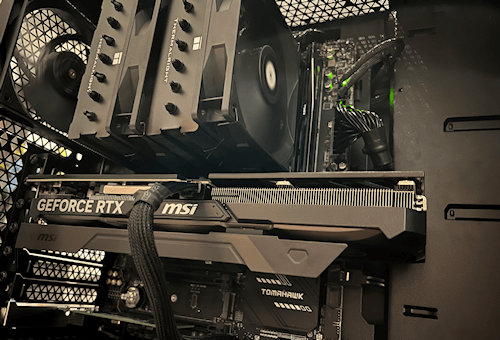
“It’s alive!”
Now, my GPUs selection strategy has always been to go with an upper end, middle tier card. For instance, my current build has a vendor overclocked GTX 1070 which I got near the start of that generation in it and it’s still going fairly strong – zero regrets! With all of this in mind, the NVIDIA GeForce GTX 4070 Ti Super seems to fit the mold perfectly. A bit more expensive, sure, but again, I’m going for longevity here. I was originally going to go with one of the cheapest ones available, the MSI Ventus 3X, but discovered that I could get that card’s slightly shorter, and now on sale, little brother the MSI Shadow 3X OC for cheaper, and without needing to order it directly from MSI. In any case, between my mobo and now my GPU, I guess this is going to be an MSI heavy build.
Monitor Selection:
So, given what I just said about picking a GPU, I don’t have to say too much here. Essentially, I just wanted a well-reviewed 27” or bigger 1440P 120 Hz+ monitor. I took a look around at some YouTube recommendation videos and narrowed my choice down to a few readily available budget monitors pretty quickly, settling on Acer Nitro XV1 XV271U which is a 1440P 180 Hz IPS monitor with pretty great reviews within its tier, with the usual caveats for a cheap IPS panel that it’s not going to have anything resembling decent HDR and its black levels and back lighting in general probably won’t be anywhere close to amazing. I’m fine with that for now, as just with TVs, while you can get some really good stuff for really cheap these days, the very best screens are still quite expensive. For the price I paid for this ($170 new) I can always replace it down the line if I feel particularly compelled to, and I probably won’t!
I also grabbed a little HDMI to DVI converter so I could keep using my old Dell 2007FPb 20” 1600×1200 monitor as a secondary display. Hopefully this works well enough, as I’ve been unable to come to grips with possibly abandoning my second screen. If I had, I’d probably have gone with a bigger primary monitor. For now, I prefer using multiple monitors, and having a dedicated 4:3 for running older PC and console games full screen is a nice bonus.
Case, Power, and Cooling:
The only real requirement I had for a case besides supporting my ATX motherboard and not looking like something off the Vegas strip, was that I wanted to bring my Plextor DVD-RW drive over from my current PC. Call me a fossil, but I do still have the rare occasion to read a CD or DVD, and possibly even write one. For better or worse, this requirement VASTLY slimmed my number of options down to single digits. I mean, I knew cases without any exposed drive bays were popular these days, but I didn’t know that they were being made almost exclusively that way. I ended up opting for a Fractal Design Pop Solid which is a pretty nice, somewhat budget case with two 5.25” drive bays hidden behind a little door. I’ve been happy with Fratcal’s cases in the past – in fact, my current machine is using one which I could have just re-used if it weren’t for making the transition practically impossible to do without a lot of downtime.
As a quick aside, in retrospect I’m a little upset with myself for not looking into smaller form factors. While they don’t save you a ton of space unless you specifically target going for as small of a footprint as you can handle, I still hate how monstrously big even a modest mid tower ATX case can be. My last build was a Micro ATX and I’m happy with it. I’ve also been reviving an old ITX build recently too. There’s two main reasons why I didn’t put much effort into going that route. First of all, case availability, as mentioned. Yet, there is actually a ”Fractal Design Pop Mini” which is practically the same case, only downsized for mATX builds, and it still includes those external bays. So, no excuses there. Beyond that, I could have easily sourced an older mATX case with external 5.25” bays too. The second, actually decent reason, is that there aren’t a lot of mATX options in the AM5 range that had the features I was looking for. In fact, there’s only a single nice mATX X670E board out there, and it’s been discontinued for long enough to drive the prices up to insane territory. Oh well. That size and weight should only be an issue when I want to move my box around for cleaning or other maintenance.
As for cooling, at first I figured the 3 included 120 mm case fans should be enough to keep the air moving well enough, but upon watching several reviews of the case I noticed a pattern of comments related to airflow, particularly affecting GPU temperatures. An easy fix is just to replace the 3 120mm Fractal Designs Aspect 12 fans with something a bit better. Since this was an unplanned, last minute addition, I ended up staying on the inexpensive side, but a Thermalright TL-G12B (120mm) for rear exhaust and 2 Thermalright TL-C14s (140mm) for front intake should greatly improve the situation. Both models have superior airflow to Fractal’s stock fans and are PWM controlled so can run slower and more quietly when I’m not gaming to boot. These replacement fans may not have really been needed, but could hopefully help in a future upgrade scenario, and this was only a ~$24 addition.
My PSU is another area I purposely went a little overboard with. By my estimates, a 750 watt power supply would have been totally fine with this build, but just in case of mid-life upgrades, I bumped it up to an 850 watt unit. I also don’t like to cheap out too much on my PSUs, so a 80+ Gold certified or better PSU is a must. Looking at some detailed reviews, tier lists, etc., I settled on a be quiet! Pure Power 12 M 850 W Fully Modular ATX Power Supply. It’s also ATX 3.1 spec’d, making wiring it up to my 4070 Ti Super a little cleaner, and further hopefully helping to ensure compatibility with a new GPU 4 or 5 years down the road. This is my first “be quiet!” brand anything, but reviews are great and the company has quite a generous warranty, so I don’t have any real worries there.
Peripherals:
I didn’t have much reason to abandon my current peripherals for this build, so I’ll be migrating my HyperX headset, my Razer keyboard and mouse, and my old Altec Lansing 2.1 speakers over. Yes, I’m as shocked as anyone that my old Razer gear is all still working after all these years (although I did replace my old DeathAdder Chroma mouse with Naga Trinity several years back, but more for the optional MMORPG button configuration than any functional issue with the DeathAdder.)
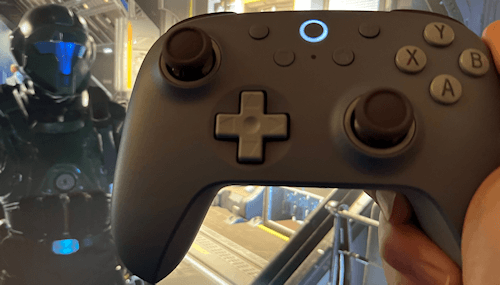
“I don’t actually play Helldivers 2 with a controller…”
The one purchase I did make was an 8bitdo Ultimate 2C Wireless Controller. This is a significant change of direction for me, because outside of emulating much older consoles, I don’t ever play PC games with anything but mouse and keyboard. With this new build though I’ve decided to tee up some console-like games in my Steam backlog, and wanted a suitable controller. I could have gone with my tried and true Xbox Series X or Xbox One controller, but instead decided to purchase something completely dedicated. The Ultimate 2C has very similar ergonomics to my beloved Xbox controllers, but despite its dirt cheap price tag, has scored some pretty impressive reviews. I’ve barely used it, but so far so good. Oh, I went with the limited edition “blueberry” color scheme, for the record.
That’s about it. Beyond all of this, the logistics around ordering so many things from numerous places can be a minor challenge, and the actual assembly is, of course, its own thing, as is making numerous adjustments to Windows 11 to make it suck a little less. In some ways, Windows 11 has been far more of adjustment than I’d have hoped for, and I definitely vastly prefer Windows 10. Back to hardware though, the only post-build change I’ve made so far has been to replace all of my case fan mounting screws with rubber pop-in “screws” (like this) to dampen an annoying pulsating hum I was getting from my 140mm fans. Despite seeing them around and probably even getting some as pack-ins before, I’d actually never used them personally or professionally before, but I’m glad to report that they seemed to do the trick. Anyway, you made it to the end. If you found this while working on your own build, good luck!
